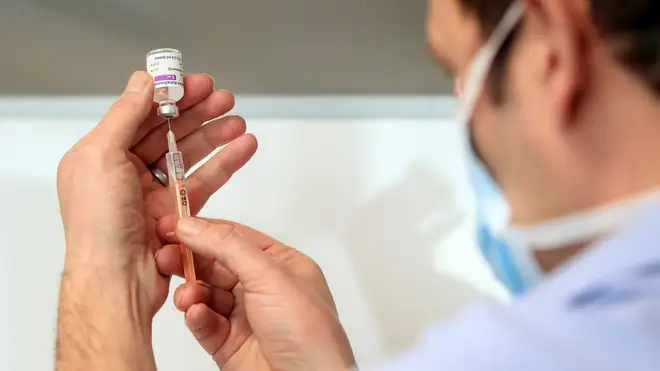
Ian Payne 4am - 7am
15 February 2021, 19:08 | Updated: 15 February 2021, 20:11

The government is on course to offer a first vaccine dose to everyone in the nine priority groups by March 30, exclusive LBC analysis suggests.
If the current vaccination rate continues in the coming weeks, the target of offering a first dose to everyone in priority groups one to nine will be met more than a month before the end of April date that minsters have set.
LBC analysed the current rate of vaccination and factored in the number of second doses that will need to be given from mid-February onwards, based on the number of first doses given during the early weeks of the vaccination programme in December and January.
We found that, at the current rate, March 30 will be the date on which more than 31.8 million first doses have been administered – equating to the number of people in the nine priority groups that the Joint Committee on Vaccination and Immunisation (JCVI) drew up for the first phase of the UK vaccination programme.
Our analysis is based on vaccine supply staying constant in the coming weeks. However, in reality ministers have suggested that supply is likely to increase in March, meaning the real date could be even earlier than 30th March.
If supply increased at a rate of even ten per cent a week, the 31.8 million figure would be exceeded as early as 18th March – just over a month away.

Boris Johnson: Roadmap out of lockdown will include key dates
But even if supply remains at current levels, crucially everyone in Groups 1-9 should still be offered a dose before the NHS needs to start administering significant number of seconds doses – a process which will inevitably slow down the vaccination programme.
Our analysis suggests that the number of second doses that will be needed is likely to remain well below 100,000 a day until the end of March, when it will start to rise significantly.
Groups 1-9 include everyone over the age of 50, those with health conditions that place them at increased risk from Covid-10, and health and care workers.
Our analysis raises the prospect of every adult in the UK being offered a vaccine dose by the summer - months before the end of August deadline that ministers have announced.
It is likely to raise fresh questions for the government as to why its second vaccination target seems significantly less ambitious than its first.
Vaccinations are currently being given at an average rate of 433,000 a day, suggesting that the UK is on course to vaccinate everyone in groups one to nine by March 25.

Boris Johnson: We want this lockdown to be the last
However, the need to start administering tens of thousands of second doses a day from the middle of February pushes the date back by five days, to March 30.
But even that could be a pessimistic forecast, given that it is premised on levels of vaccine supply staying the same as they are now. In reality, ministers have suggested that supply will increase in the coming weeks.
If supply were to increase by even 10 per cent a week, then all groups one to nine would be offered a first jab by March 18 and more than 850,000 doses a day could be being administered by the end of March.
That would allow the NHS to speed through vaccinating the remaining 20 million adults who are under the age of 50 and do not fall into any of the priority groups in a matter of weeks – allowing for a summer in which the vast majority of adults would have some protection from Covid, and restrictions could be relaxed accordingly.
That may seem highly ambitious, but there is no reason to think it is not feasible.
Indeed, at the Downing Street press conference on Monday, Sir Simon Stevens, head of NHS England, directly raised the prospect of vaccination rates doubling in the coming weeks.
He said: “In this next phase, this second sprint, actually we’re going to be vaccinating a larger number of people than in the first sprint.
“Overall, although supply will vary week-to-week and we’ll have to adjust accordingly, we may be giving up to twice as many vaccinations overall, given we’ve got to be doing the second doses as well, than we’ve done in the first sprint.”